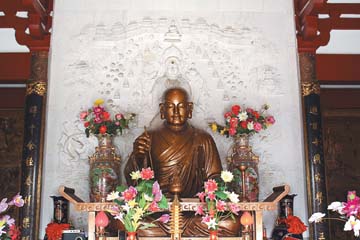 James Baquet LINGGU Temple is located in Linggu Park, an incredibly interesting area in the east of Nanjing that would take a full day or more to appreciate. Unfortunately, as I was intending to push on to Zhenjiang that afternoon, I had only part of a morning to see it. The temple is overshadowed in popularity by its neighbor, the mausoleum of the “Father of Modern China” Dr. Sun Yat-sen. Also nearby are the Ming-Dynasty “Beamless Hall” with its life-size historical dioramas; Linggu Tower, built by the Nationalists in 1931-1933; and the Pine-wind Pavilion, once a discipline hall of the temple, then a 1931 Memorial Hall of the Revolution, and now a souvenir shop. The temple compound itself is quite small and fairly ordinary (though one Web site claims that it calls itself “the best Buddhist temple in the world” — a bit of promotional hyperbole). But one very fine aspect of the temple is the hall (built 2003-2005) housing a genuine relic of the famous Tang Dynasty monk Xuanzang, who journeyed to India (629-645). A relic is meaningless without context; to give the relic its due significance, the hall has been built in the Tang style, and has magnificent reliefs depicting Xuanzang’s life and journey. The statue of the Tang monk in the center of the hall is one of the best I’ve seen (and I’ve seen a lot). If you ever have a spare day in Nanjing, I suggest you spend it in the Linggu Scenic Area; you won’t be disappointed. | 
